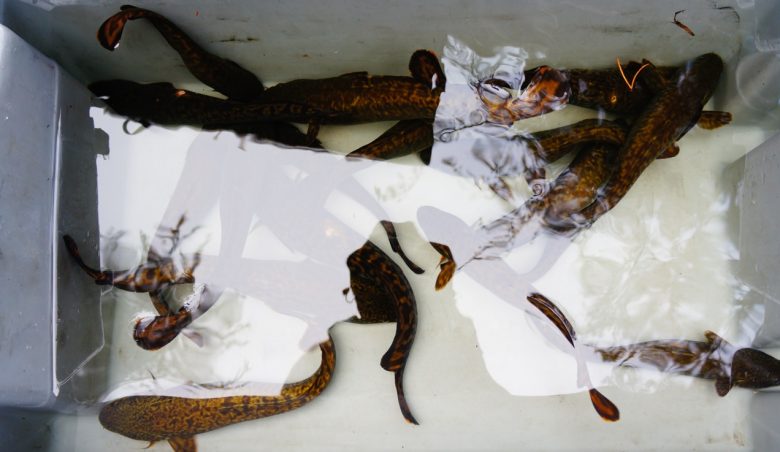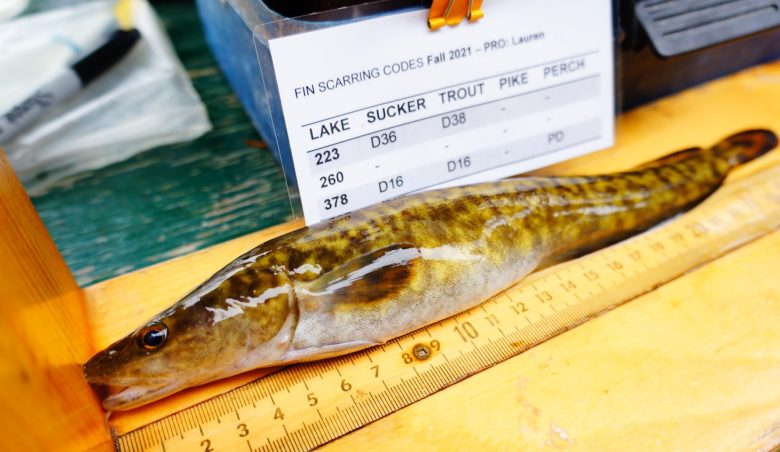Research February 14, 2022
To Burbot or Not to Burbot: A case for studying the lesser-known and lesser-loved Lota lota
By Marco Haust, Fisheries Research Technician, Lauren Hayhurst , Fisheries Research Biologist
What is a burbot?
The burbot (Lota lota) is a species of freshwater fish found deep in lakes and rivers all over North America, Europe, and Asia. They are the only freshwater cod species in Canada and are known by different names regionally, such as mariah, lingcod, or eelpout.
They have characteristically large heads, slimy skin, soft round fins, and a fleshy growth called a barbel on their chins, which allows them to feel along lake and river bottoms in darker waters.
Burbot are often caught ice fishing, but they do not receive much fanfare as a sport fish. They’re eel-like, they have whiskers, they have a face that only a fish biologist could love, they will wrap themselves around your arm when handled, and there is a common misconception that they are only bottom feeders. Many anglers are disappointed when they pull a burbot out of the water, sometimes to the point where the fish are left to die on the ice atop a frozen lake.
What many people don’t know is that burbot are as flexible in their life history as there are in their morphology! They can tolerate a wide variety of temperatures from juvenile to adult stages, they inhabit diverse aquatic ecosystems from shallow streams to deep lakes, and they range across almost the entirety of Canada. Not to mention, they are delicious; but what else would you expect from a relative of cod?

Burbot can’t burp!
The swim bladder is a gas-filled organ that allows fish to control how buoyant they are. By changing the amount of air to adjust to the pressure at different depths, they stabilize themselves in the water column! There are two types of swim bladders – “physostomous” (with a duct) and “physoclistous” (without a duct). Physostome fishes, like trout, pike, catfish, and drum, can gulp in and burp out air, which helps them move quickly up and down in the water column (have you ever heard them burp?). However, fishes like burbot, walleye, perch, and bass have physoclist swim bladders, which take a much longer time to expel extra gas if they are brought quickly to the surface (they can’t burp!). So, if you reel these fish in too fast, their swim bladder may over-inflate and extend out of their mouth; if these fish are released back into the water, it will take them a much longer time to recover, and they may die.
Did you know? Swim bladders also function as a resonating chamber and reflect sound, which is used in sonar fish-finding equipment. Even better, burbot are “soniferous” fish: they can vocalize by rapidly contracting drumming muscles that are attached to their swim bladder. Burbot make a wide variety of sounds—from slow knocking to fast buzzing—while spawning, which is likely an important tool since they cannot use visual cues to mate in the dark under all that ice cover!
Burbot and microplastics at the world’s freshwater laboratory
Researchers and students from numerous universities are exploring the impacts of microplastics on freshwater fish health at IISD-ELA. During the summer of 2021, they added coloured microplastics to enclosures in Lake 378, with plans for further additions, to study how microplastics affect freshwater systems and aquatic organisms.
During initial background fisheries sampling, burbot were found in moderate abundance in our nets, set at 1–4-m depths in the lake. Burbot are found in other lakes around the site, but these lakes are much larger and deeper than the 25.5 ha and 16.2 m maximum depth of Lake 378, providing more typical-to-northwestern-Ontario habitat for adult burbot populations. So this is the first time we are conducting long-term monitoring efforts in a lake where they are present.
Burbot are especially interesting to have in this study lake, as they are flexible in their consumption (i.e., anything they come across that can fit in their mouths)—fish, eggs, detritus, or even plastic!

Using one method of population estimation, the Schnabel method, we have so far estimated that there are about 75 adult burbot in Lake 378. Each individual that we have captured has been given a Passive Integrated Transponder (PIT) tag, which contains a unique 15-digit number (kind of like their “name”) that is entered into our database so we can track changes in their growth and condition over time. Briefly, by looking at the number of occasions these tagged individuals appear in our nets within the same season, we can get a sense of their adult numbers in the lake at this sampled stage of maturity. With future spring and fall sampling occasions during the experimental additions and recovery portions of the project, we will develop more robust population estimates of the burbot in Lake 378, along with the other large-bodied fishes, and see how the addition of microplastics may affect their growth, condition, or numbers in the lake.
A *full* feeling
The burbot in Lake 378 have voracious appetites.
They gorge themselves on smaller fish species, like shiners, dace, and perch, while they hang out in our nets in-between our 2- to 3-day checks. This feeding frenzy means that—unlike other large-bodied fish species at IISD-ELA—their weights vary day-to-day during a sampling season. In response, IISD-ELA fish biologist and designated Lake 378 processer Lauren Hayhurst has begun to qualitatively assess the “fullness” of each burbot in the field on the super-scientific scale that includes “moderately full,” “full,” and “extremely full.” Other qualitative assessments involve changing colours and behaviours in fish; burbot sometimes take on a greenish hue and have trouble righting themselves in the recovery bath after processing, since they are so bloated with fish.

While we expect fish to grow larger and weigh more with every field season, most of our burbot gain weight during the 3- to 4-week fishing effort, and the qualitative fullness scale proves surprisingly accurate when we look at the data after each field season. It is very common for a burbot individual to gain 20%–40% of its initial body weight during a few weeks; one burbot ate so much that it weighed 62% more on October 2 than it did on October 12 of the same year. That’s the same as a 150-pound person gaining 93 pounds in 9 days!
To date, our greatest burbot haul occurred on October 15, 2021, with a total of 36 burbot in the nets! The smallest (and likely only juvenile) burbot we have on record weighed in at 14 g and measured 130 mm from tip of snout to tip of tail, while the largest was 515 g and 427 mm long; this is compared to the world record burbot caught in Lake Diefenbaker, Saskatchewan, in 2010, weighing in at 11.4 kg (or over 25 lb) (International Game Fish Association, 2010). At times like these, we are reminded that we work on small, low-nutrient “oligotrophic” lakes that support small fish populations, so it is important to keep our fishes alive and happy.

Stay tuned in the coming years for more information on our work on microplastics and our featured study of the (arguably) most adorable and most interesting fish at IISD Experimental Lakes Area.